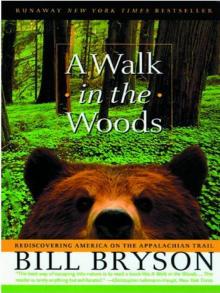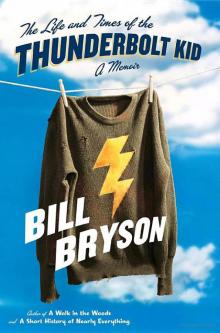- Home
- Bill Bryson
A Walk in the Woods Page 5
A Walk in the Woods Read online
Page 5
I waited for Katz for three-quarters of an hour, then went looking for him. The light was fading and the air was taking on an evening chill. I walked and walked, down the hill and through the endless groves of trees, back over ground that I had gratefully put behind me forever, or so I had thought. Several times I called his name and listened, but there was nothing. I walked on and on, over fallen trees I had struggled over hours before, down slopes I could now only dimly recall. My grandmother could have got this far, I kept thinking. Finally, I rounded a bend and there he was stumbling towards me, wild-haired and one-gloved and nearer hysteria than I have ever seen a grown person.
It was hard to get the full story out of him in a coherent flow, because he was so furious, but I gathered he had thrown many items from his pack over a cliff in a temper. None of the things that had been dangling from the outside were there any longer.
“What did you get rid of?” I asked, trying not to betray too much alarm.
“Heavy fucking shit, that’s what. The pepperoni, the rice, the brown sugar, the Spam, I don’t know what all. Lots. Fuck.” Katz was almost cataleptic with displeasure. He acted as if he had been deeply betrayed by the trail. It wasn’t, I guess, what he had expected.
I saw his glove lying in the path thirty yards back and went to retrieve it.
“OK,” I said when I returned, “you haven’t got too far to go.”
“How far?”
“Maybe a mile.”
“Shit,” he said bitterly.
“I’ll take your pack.” I lifted it onto my back. It wasn’t exactly empty now, but it was decidedly moderate in weight. God knows what he had thrown out.
We trudged up the hill to the summit in the enveloping dusk. A few hundred yards beyond the summit was a campsite with a wooden shelter in a big grassy clearing against a backdrop of dark trees. There were a lot of people there, far more than I’d expected this early in the season. The shelter — a basic, three-sided affair with a sloping roof — looked crowded, and a dozen or so tents were scattered around the open ground. Nearly everywhere there was the hiss of little campstoves, threads of rising food smoke, and the movements of lanky young people.
I found us a site on the edge of the clearing, almost in the woods, off by ourselves.
“I don’t know how to put up my tent,” Katz said in a petulant tone.
“Well, I’ll put it up for you then.” You big soft flabby baby. Suddenly I was very tired.
He sat on a log and watched me put up his tent. When I finished, he pushed in his pad and sleeping bag and crawled in after. I busied myself with my tent, fussily made it into a little home. When I completed my work and straightened up, I realized there was no sound or movement from within his.
“Have you gone to bed?” I said, aghast.
“Yump,” he replied in a kind of affirmative growl.
“That’s it? You’ve retired? With no dinner?”
“Yump.”
I stood for a minute, speechless and flummoxed, too tired to be indignant. Too tired to be hungry either, come to that. I crawled into my tent, brought in a water bottle and book, laid out my knife and flashlight for purposes of nocturnal illumination and defense, and finally shimmied into the bag, more grateful than I have ever been to be horizontal. I was asleep in moments. I don’t believe I have ever slept so well.
When I awoke, it was daylight. The inside of my tent was coated in a curious flaky rime, which I realized after a moment was my all my nighttime snores, condensed and frozen and pasted to the fabric, as if into a scrapbook of respiratory memories. My water bottle was frozen solid. This seemed gratifyingly macho, and I examined it with interest, as if it were a rare mineral. I was surprisingly snug in my bag and in no hurry at all to put myself through the foolishness of climbing hills, so I just lay there as if under grave orders not to move. After a while I became aware that Katz was moving around outside, grunting softly as if from aches and doing something that sounded improbably industrious.
After a minute or two, he came and crouched by my tent, his form a dark shadow on the fabric. He didn’t ask if I was awake or anything, but just said in a quiet voice: “Was I, would you say, a complete asshole last night?”
“Yes you were, Stephen.”
He was quiet a moment. “I’m making coffee.” I gathered this was his way of an apology.
“That’s very nice.”
“Damn cold out here.”
“And in here.”
“My water bottle froze.”
“Mine, too.”
I unzipped myself from my nylon womb and emerged on creaking joints. It seemed very strange — very novel — to be standing outdoors in long Johns. Katz was crouched over the campstove, boiling a pan of water. We seemed to be the only campers awake. It was cold, but perhaps just a trifle warmer than the day before, and a low dawn sun burning through the trees looked cautiously promising.
“How do you feel?” he said.
I flexed my legs experimentally. “Not too bad, actually.”
“Me either.”
He poured water into the filter cone. “I’m going to be good today,” he promised.
“Good.” I watched over his shoulder. “Is there a reason,” I asked, “why you are filtering the coffee with toilet paper?”
“I, oh… I threw out the filter papers.”
I gave a sound that wasn’t quite a laugh. “They couldn’t have weighed two ounces.”
“I know, but they were great for throwing. Fluttered all over.” He dribbled on more water. “The toilet paper seems to be working OK, though.”
We watched it drip through and were strangely proud. Our first refreshment in the wilderness. He handed me a cup of coffee. It was swimming in grounds and little flecks of pink tissue, but it was piping hot, which was the main thing.
He gave me an apologetic look. “I threw out the brown sugar too, so there won’t be any sugar for the oatmeal.”
Ah. “Actually, there won’t be any oatmeal for the oatmeal. I left it in New Hampshire.”
He looked at me. “Really?” then added, as if for the record: “I love oatmeal.”
“What about some of that cheese?”
He shook his head. “Flung.”
“Peanuts?”
“Flung.”
“Spam?”
“Really flung.”
This was beginning to sound a trifle grave. “What about the baloney?”
“Oh, I ate that at Amicalola,” he said, as if it had been weeks ago, then added in a tone of sudden magnanimous concession, “Hey, I’m happy with a cup of coffee and a couple of Little Debbies.”
I gave a small grimace. “I left the Little Debbies, too.”
His face expanded. “You left the Little Debbies?”
I nodded apologetically.
“All of them?”
I nodded.
He breathed out hard. This really was grave — a serious challenge, apart from anything else, to his promised equanimity. We decided we had better take inventory. We cleared a space on a groundsheet and pooled our commissary. It was startlingly austere — some dried noodles, one bag of rice, raisins, coffee, salt, a good supply of candy bars, and toilet paper. That was about it.
We breakfasted on a Snickers bar and coffee, packed up our camp, hoisted our packs with a sideways stagger, and set off once again.
“I can’t believe you left the Little Debbies,” Katz said, and immediately began to fall behind.
Chapter 4
Woods are not like other spaces. To begin with, they are cubic. Their trees surround you, loom over you, press in from all sides. Woods choke off views and leave you muddled and without bearings. They make you feel small and confused and vulnerable, like a small child lost in a crowd of strange legs. Stand in a desert or prairie and you know you are in a big space. Stand in a woods and you only sense it. They are a vast, featureless nowhere. And they are alive.
So woods are spooky. Quite apart from the thought that they may harbor wild
beasts and armed, genetically challenged fellows named Zeke and Festus, there is something innately sinister about them, some ineffable thing that makes you sense an atmosphere of pregnant doom with every step and leaves you profoundly aware that you are out of your element and ought to keep your ears pricked. Though you tell yourself it’s preposterous, you can’t quite shake the feeling that you are being watched. You order yourself to be serene (it’s just a woods for goodness sake), but really you are jumpier than Don Knotts with pistol drawn. Every sudden noise — the crack of a falling limb, the crash of a bolting deer — makes you spin in alarm and stifle a plea for mercy. Whatever mechanism within you is responsible for adrenaline, it has never been so sleek and polished, so keenly poised to pump out a warming squirt of adrenal fluid. Even asleep, you are a coiled spring.
The American woods have been unnerving people for 300 years. The inestimably priggish and tiresome Henry David Thoreau thought nature was splendid, splendid indeed, so long as he could stroll to town for cakes and barley wine, but when he experienced real wilderness, on a visit to Katahdin in 1846, he was unnerved to the core. This wasn’t the tame world of overgrown orchards and sun-dappled paths that passed for wilderness in suburban Concord, Massachusetts, but a forbidding, oppressive, primeval country that was “grim and wild… savage and dreary,” fit only for “men nearer of kin to the rocks and wild animals than we.” The experience left him, in the words of one biographer, “near hysterical.”
But even men far tougher and more attuned to the wilderness than Thoreau were sobered by its strange and palpable menace. Daniel Boone, who not only wrestled bears but tried to date their sisters, described corners of the southern Appalachians as “so wild and horrid that it is impossible to behold them without terror.” When Daniel Boone is uneasy, you know it’s time to watch your step.
When the first Europeans arrived in the New World, there were perhaps 950 million acres of woodland in what would become the lower forty-eight states. The Chattahoochee Forest, through which Katz and I now trudged, was part of an immense, unbroken canopy stretching from southern Alabama to Canada and beyond, and from the shores of the Atlantic to the distant grasslands of the Missouri River.
Most of that forest is now gone, but what survives is more impressive than you might expect. The Chattahoochee is part of four million acres — 6,000 square miles — of federally owned forest stretching up to the Great Smoky Mountains and beyond and spreading sideways across four states. On a map of the United States it is an incidental smudge of green, but on foot the scale of it is colossal. It would be four days before Katz and I crossed a public highway, eight days till we came to a town.
And so we walked. We walked up mountains and through high, forgotten hollows, along lonesome ridges with long views of more ridges, over grassy balds and down rocky, twisting, jarring descents, and through mile after endless mile of dark, deep, silent woods, on a wandering trail eighteen inches wide and marked with rectangular white blazes (two inches wide, six long) slapped at intervals on the grey-barked trees. Walking is what we did.
Compared with most other places in the developed world, America is still to a remarkable extent a land of forests. One-third of the landscape of the lower forty-eight states is covered in trees — 728 million acres in all. Maine alone has 10 million uninhabited acres. That’s 15,600 square miles, an area considerably bigger than Belgium, without a single permanent resident. Altogether, just 2 percent of the United States is classified as built up.
About 240 million acres of America’s forests are owned by the government. The bulk of this — 191 million acres, spread over 155 parcels of land — is held by the U.S. Forest Service under the designations of National Forests, National Grasslands, and National Recreation Areas. All this sounds soothingly untrampled and ecological, but in fact a great deal of Forest Service land is designated “multiple-use,” which is generously interpreted to allow any number of boisterous activities — mining, oil, and gas extraction; ski resorts (137 of them); condominium developments; snowmobiling; off-road vehicle scrambling; and lots and lots and lots of logging — that seem curiously incompatible with woodland serenity.
The Forest Service is truly an extraordinary institution. A lot of people, seeing that word forest in the title, assume it has something to do with looking after trees. In fact, no — though that was the original plan. It was conceived a century ago as a kind of woodland bank, a permanent repository of American timber, when people grew alarmed at the rate at which American forests were falling. Its mandate was to manage and protect these resources for the nation. These were not intended to be parks. Private companies would be granted leases to extract minerals and harvest timber, but they would be required to do so in a restrained, intelligent, sustainable way.
In fact, mostly what the Forest Service does is build roads. I am not kidding. There are 378,000 miles of roads in America’s national forests. That may seem a meaningless figure, but look at it this way — it is eight times the total mileage of America’s interstate highway system. It is the largest road system in the world in the control of a single body. The Forest Service has the second highest number of road engineers of any government institution on the planet. To say that these guys like to build roads barely hints at their level of dedication. Show them a stand of trees anywhere and they will regard it thoughtfully for a long while, and say at last, “You know, we could put a road here.” It is the avowed aim of the U.S. Forest Service to construct 580,000 miles of additional forest road by the middle of the next century.
The reason the Forest Service builds these roads, quite apart from the deep pleasure of doing noisy things in the woods with big yellow machines, is to allow private timber companies to get to previously inaccessible stands of trees. Of the Forest Service’s 150 million acres of loggable land, about two-thirds is held in store for the future. The remaining one-third — 49 million acres, or an area roughly twice the size of Ohio — is available for logging. It allows huge swathes of land to be clear-cut, including (to take one recent but heartbreaking example) 209 acres of thousand-year-old redwoods in Oregon’s Umpqua National Forest.
In 1987, it casually announced that it would allow private timber interests to remove hundreds of acres of wood a year from the venerable and verdant Pisgah National Forest, next door to the Great Smoky Mountains National Park, and that 80 percent of that would be through what it delicately calls “scientific forestry” — clear-cutting to you and me — which is not only a brutal visual affront to any landscape but brings huge, reckless washoffs that gully the soil, robbing it of nutrients and disrupting ecologies farther downstream, sometimes for miles. This isn’t science. It’s rape.
And yet the Forest Service grinds on. By the late 1980s — this is so extraordinary I can hardly stand it — it was the only significant player in the American timber industry that was cutting down trees faster than it replaced them. Moreover, it was doing this with the most sumptuous inefficiency. Eighty percent of its leasing arrangements lost money, often vast amounts. In one typical deal, the Forest Service sold hundred-year-old lodgepole pines in the Targhee National Forest in Idaho for about $2 each after spending $4 per tree surveying the land, drawing up contracts, and, of course, building roads. Between 1989 and 1997, it lost an average of $242 million a year — almost $2 billion all told, according to the Wilderness Society. This is all so discouraging that I think we’ll leave it here and return to our two lonely heroes trudging through the lost world of the Chattahoochee.
The forest we walked through now was really just a strapping adolescent. In 1890, a railroad man from Cincinnati named Henry C. Bagley came to this part of Georgia, saw the stately white pines and poplars, and was so moved by their towering majesty and abundance that he decided to chop them all down. They were worth a lot of money. Besides, freighting the timber to northern mills would keep his railroad cars puffing. In consequence, over the next thirty years, nearly all the hills of northern Georgia were turned into sunny groves of stumps. By 1920, f
oresters in the South were taking away 15.4 billion board feet of timber a year. It wasn’t until the 1930s, when the Chattahoochee Forest was officially formed, that nature was invited back in.
There is a strange frozen violence in a forest out of season. Every glade and dale seemed to have just completed some massive cataclysm. Downed trees lay across the path every fifty or sixty yards, often with great bomb craters of dirt around their splayed roots. Dozens more lay rotting on the slopes, and every third or fourth tree, it seemed, was leaning steeply on a neighbor. It was as if the trees couldn’t wait to fall over, as if their sole purpose in the universal scheme of things was to grow big enough to topple with a really good, splintering crash. I was forever coming up to trees so precariously and weightily tipped over the path that I would waver, then scoot under, fearing the crush of really unfortunate timing and imagining Katz coming along a few minutes later, regarding my wriggling legs and saying, “Shit, Bryson, what’re you doing under there?” But no trees fell. Everywhere the woods were still and preternaturally quiet. Except for the occasional gurgle of running water and the tiny shuffle of wind-stirred leaves along the forest floor, there was almost never a sound.
The woods were silent because spring had not yet come. In a normal year we would be walking into the zestful bounty of a southern mountain spring, through a radiant, productive, newborn world alive with the zip of insects and the fussy twitter of birds — a world bursting with fresh wholesome air and that rich, velvety, lung-filling smell of chlorophyll you get when you push through low, leafy branches. Above all, there would be wildflowers in dazzling profusion, blossoming from every twig, pushing valiantly through the fertile litter on the forest floor, carpeting every sunny slope and stream bank — trillium and trailing arbutus, Dutchmen’s breeches, jack-in-the-pulpit, mandrake, violets, snowy bluets, buttercups and bloodroot, dwarf iris, columbine and wood sorrel, and other cheerful, nodding wonders almost beyond counting. There are 1,500 types of wildflower in the southern Appalachians, 40 rare types in the northern Georgia woods alone. They are a sight to lift the hardest heart. But they were not to be seen in the woods this grim March. We trudged through a cold, silent world of bare trees, beneath pewter skies, on ground like iron.

 Notes from a Small Island
Notes from a Small Island A Short History of Nearly Everything
A Short History of Nearly Everything A Walk in the Woods
A Walk in the Woods I'm a Stranger Here Myself
I'm a Stranger Here Myself The Mother Tongue
The Mother Tongue Shakespeare
Shakespeare A Short History of Nearly Everything: Special Illustrated Edition
A Short History of Nearly Everything: Special Illustrated Edition The Best American Travel Writing 2016
The Best American Travel Writing 2016 The Road to Little Dribbling
The Road to Little Dribbling The Life And Times Of The Thunderbolt Kid: A Memoir (v5.0)
The Life And Times Of The Thunderbolt Kid: A Memoir (v5.0) Made In America
Made In America Seeing Further
Seeing Further Shakespeare: The World as Stage
Shakespeare: The World as Stage The Life and Times of the Thunderbolt Kid
The Life and Times of the Thunderbolt Kid At Home
At Home Bryson's Dictionary For Writers And Editors (v5.0)
Bryson's Dictionary For Writers And Editors (v5.0) Neither Here Nor There
Neither Here Nor There Bill Bryson's African Diary
Bill Bryson's African Diary